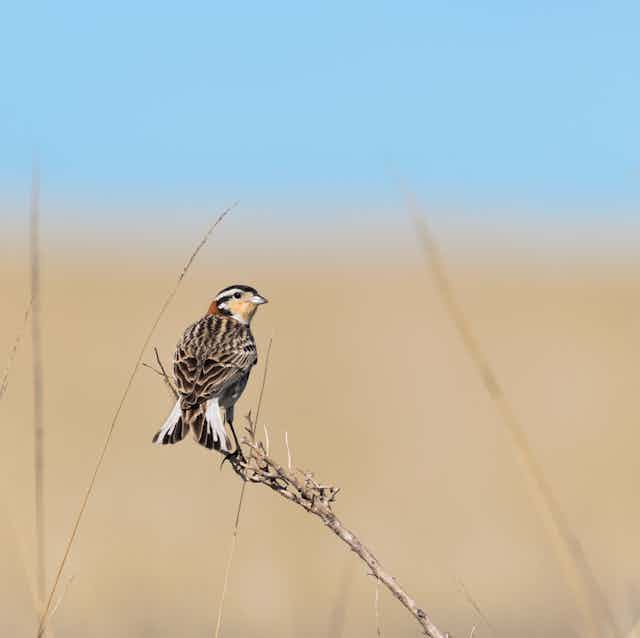Grassland songbirds have been steadily decreasing for decades in Canada. In addition to having to endure strenuous migration every year, they are confronted with the symphonies of oil extraction and drilling once they finally reach their prairie breeding grounds.
This noise pollution may increase risks to species that are already experiencing significant population declines by further reducing their abundance, interfering with predator–prey dynamics and acoustic communication, and acting as a physiological stressor.
Our recent study investigating the effects of oil noise on grassland songbirds found that they were not necessarily bothered by noise from oil wells that were operating non-stop during the whole breeding season. Rather, short-term drilling noise had a large impact on reproductive success, likely due to the unpredictability and suddenness of operating machinery.
Longer noise exposure is not necessarily worse, what really matters is the quality of the noise; unpredictable noise is much more harmful to these breeding birds.
Noise playback
My doctoral research at the University of Manitoba focused on identifying the effects of oil industry noise on grassland songbirds.
It is relatively easy for oil producers to reduce noise with noise reduction barriers or mufflers, unlike physical habitat alterations, and noise affects a much larger surface area than the physical infrastructure oil development occupies. However, noise comes with lots of other disturbances that birds may be avoiding.
My team and I designed a high-fidelity, solar-powered playback system that was capable of reproducing noise coming from oil wells and drilling rigs. We needed to make sure that we were testing the birds’ responses to the noise, and not to the visual of a very large pumpjack moving up and down across the flat prairie, or the access roads surrounding the oil wells.
We recorded sound produced by real oil infrastructure in our study area located in southeastern Alberta. We then broadcast drilling noise for two periods of 10 days, and oil well noise for 90 days non-stop during the breeding season. We surveyed whether there were impacts on abundance and reproductive success for four bird species: chestnut-collared longspur, Savannah sparrow, Sprague’s pipit and vesper sparrow.
From 2013 to 2015, we conducted surveys where we counted all the birds seen and heard up to 400 metres from the sound source. To find nests, we dragged a weighted rope across our study sites to flush the adult off the nest and marked it. We then monitored nests every two to four days.

Disrupting noises
Surprisingly, noise produced by the drilling of new wells, which occurs during a brief period, had greater impacts on nesting birds than constant noise produced by oil wells. This finding is contrary to current federal guidelines proposed to reduce risk to migratory birds, which suggest greater setback distances between the nest and source of disturbance based on how loud the noise is. The guidelines consider infrequent or quick disturbances as lower risk, and frequent or lasting disturbances as higher risk.
While short periods of oil drilling may have been viewed as less disruptive to migratory grassland songbirds, our recent study shows that this type of noise is actually more disruptive than constant oil well noise.
When considering psychological studies conducted in humans, our findings may not be as unexpected as we originally thought. Imagine trying to read this article next to a construction site. The constant sound of a loud generator would be annoying, but you would be able to tune it out and get back to focusing on your task. However, if the construction noise consists of bursts of unpredictable, loud and intrusive noises — like trucks backing up, horns honking, yelling and pipes banging — you will have a harder time overcoming those distractions even if they lasted for a brief period.
In this scenario, the noise distractions result in greater difficulty reading, but for birds, the consequences could include impaired ability to detect predators and missed feeding opportunities.

Increased drilling
In response to the current geopolitical climate, and concerns over rising oil and gas prices, the Canadian Association of Energy Contractors recently announced an increase in the number of drilling operations for the year.
Following the collapse in demand for oil during the pandemic, many existing oil wells were idled. Once a well has been idle for 10 months, there is only a 50 per cent chance it will ever produce again. Hence, it is not surprising that an increased number of new oil wells are expected to be drilled.
In light of our findings, this upsurge in drilling activity could mean greater risk for our grassland songbirds. However, this is an opportunity to work collaboratively with the oil industry. They could shift the timing of their drilling activities outside of the breeding season, which is May through July.
Alternatively, oil producers could use noise reduction measures. Sound attenuation barriers are currently being used in urban areas to address the impacts of noise pollution on people. Using them in more rural areas to protect wildlife could reduce the industry’s negative impact on breeding grassland songbirds.

